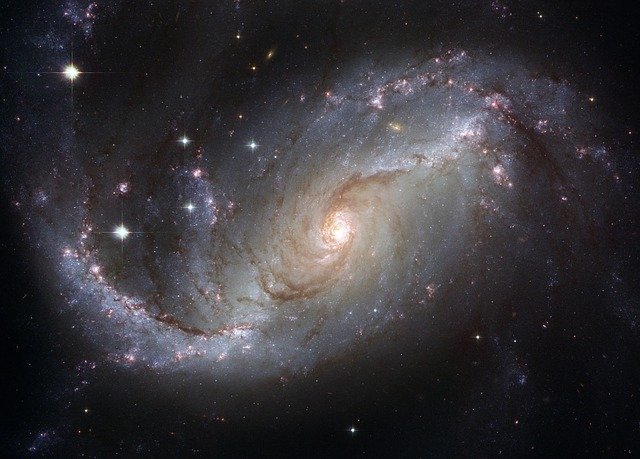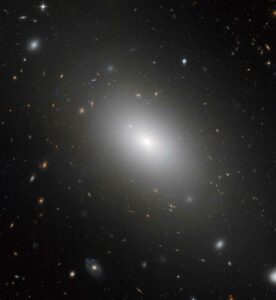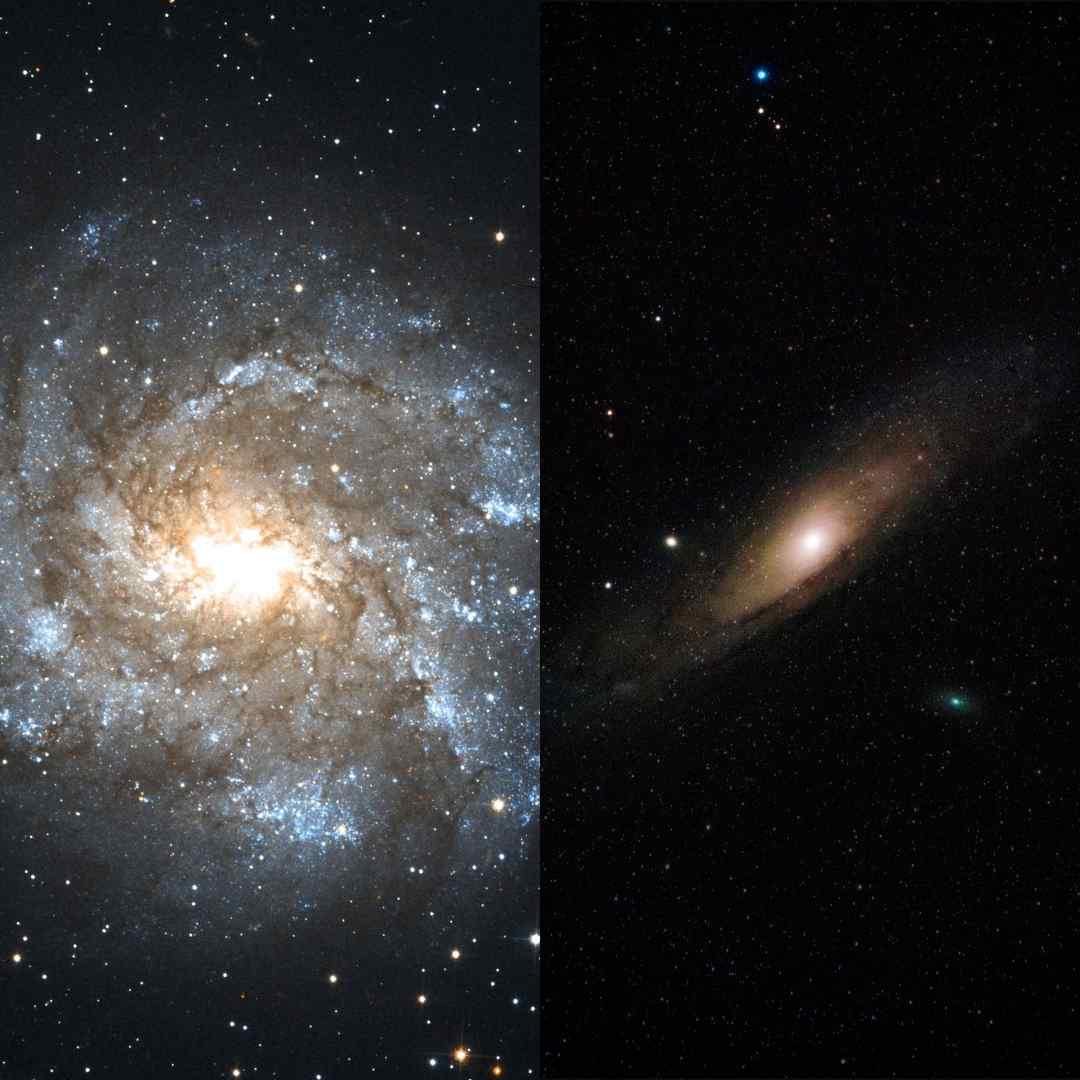*This post may contain affiliate links. This means we may make a commission if you purchase an item using one of our links*
Astronomers classify galaxies in three main categories – elliptical, spiral and irregular – with spiral and elliptical galaxies being those most observed to date.
Both types of galaxy possess halos extending beyond their visible portions and both are thought to contain a supermassive black hole at their centre. Beyond shape, spiral and elliptical galaxies differ in terms of the age of their stars, their motion and physical make-up.
Spiral galaxies and elliptical galaxies are both fascinating astronomical systems which come in a range of diverse sizes and appearances. If you’d like to learn more about these two varieties of galaxy, then carry on reading to discover key facts, main features and how they compare to one another.
What Is A Spiral Galaxy?
Table of Contents

Spiral galaxies are named for their shape which is characterized by arms of brighter stars spiraling out from a flat spinning disk of duller stars. The overall appearance is an effect of the fact that these galaxies are spinning at speeds of hundreds of kilometers per second. Our own galaxy, the Milky Way, is a spiral galaxy which rotates at 210 km per second.
A dense bulging cluster of older stars forms the centre of the spiral galaxy’s disk, with a supermassive black hole believed to lie at the centre of this bulge. In the Milky Way, our own Sun is just one of 100 – 400 billion stars spinning around a supermassive black hole called Sagittarius A*, whose mass is as great as four million suns.
A bar-shaped distribution of stars runs across the bulge in around two thirds of spiral galaxies, including the Milky Way. The mass, brightness and size of a spiral galaxy and its components varies.
Spiral galaxies are the most common type of galaxy observed by astronomers to date, making up more than two thirds of the galaxies observed in a 2010 survey of Hubble Space Telescope data, and significantly outnumbering observed elliptical or irregular galaxies.
NB This means that they are brighter and easier to spot, rather than actually being more numerous. Elliptical galaxies are believed to outnumber spiral galaxies but are less visible.
What is an Elliptical Galaxy?

Elliptical galaxies also named for their shape, being generally rounded and sometimes stretched more along one axis than another to give a cigar-type ellipse. The extent to which they are “squashed” is signified by classifying them from E0 (circular ball shape) to E7 (long, thin, cigar shape).
The largest galaxies in the known universe are elliptical although not all elliptical galaxies are formed on this scale.
They can range from giant elliptical galaxies containing a trillion stars and measuring two light-years across, to dwarf elliptical galaxies which may be less than 10% the size of the Milky Way or even so small that our telescopes may struggle to detect them.
While more spiral galaxies have been identified by astronomers, elliptical galaxies are actually thought to be more numerous, if less flashy and visible.
When specific sections of the sky are observed in depth, more elliptical galaxies tend to be found and if this pattern is repeated throughout the universe it would make them far more common.
Similarities Between Spiral And Elliptical Galaxies
Spiral and elliptical galaxies do have some features in common.
Contents
Both spiral and elliptical galaxies are made up of varying proportions of stars, gases, dust and dark matter.
Gravity
The force of gravity holds together the component parts of both spiral and elliptical galaxies.
Galactic motion
In both spiral and elliptical galaxies stars are orbiting the galactic center.
Black holes
Both types of galaxy are believed to contain supermassive black holes at their centers, millions or even billions of times as massive as our own Sun. Astronomers detect black holes by observing their effect on stars and gas nearby.
Halo
Both types of galaxy possess roughly spherical ‘halos’ of scattered stars, gases and dark matter extending beyond their visible portions. Galactic halos are clearer in spiral galaxies where the spherical halo contrasts with the shape of the flat disk. In an elliptical galaxy, distinction in shape is less defined.
Differences Between Spiral And Elliptical Galaxies
There are a number of interesting differences between spiral and elliptical galaxies, many of them interrelated and flowing from physical properties and features of these galaxies.
Galactic motion
While stars in both types of galaxy orbit the galactic center, those in elliptical galaxies orbit in more random directions than spiral galaxies because they are not guided by the same rotational forces.
In an elliptical galaxy fast-moving stars can travel further than slow-moving stars gravity draws them back onto their returning path. This creates the elliptical galaxy’s long axis in the direction of stellar movement.
Age of stars
On average the stars found in a spiral galaxy are younger than those found in other types of galaxy. Elliptical galaxies tend to contain large numbers of older stars.
Physical contents
Elliptical galaxies contain less dust and other interstellar matter than spiral galaxies which tend to have lots of dust and gas in their spiraling arms.
Star formation
Spiral galaxies are constantly generating new stars at their spiral arms. In comparison, few new stars are known to form in elliptical galaxies. This is largely explained by the fact that they contain less gas, which would be needed to support star formation.
Brightness
Younger stars in spiral galaxies shine more brightly than the older red stars which predominate in elliptical galaxies. Spiral galaxies therefore tend to be brighter and easier to spot than elliptical galaxies.
Spiral galaxies have an intrinsic brightness of around 1010 to 1012 Solar Luminosities, while elliptical galaxies have around 106 to 1012 Solar Luminosities.
Color
Elliptical galaxies are more red in color due to their greater number of older red stars. Spiral galaxies have blue color in their arms where younger, bluer stars are formed, and red color at their center where older red stars are situated.
Summary
Spiral and elliptical galaxies are both sprawling astronomical systems containing stars, dust, gas and dark matter, surrounded by a similarly composed galactic halo.
Stars in both galaxy types orbit around a galactic centre, which is thought to hold a supermassive black hole. Spiral galaxies are brighter and more colorful than elliptical galaxies, mainly due to their generation of more new young stars. Unlike spiral galaxies, elliptical galaxies do not rotate.
References
https://hubblesite.org/science/galaxies
https://www.nationalgeographic.com/science/article/galaxies
https://imagine.gsfc.nasa.gov/science/objects/galaxies1.html
https://spaceplace.nasa.gov/galactic-explorer/en/
https://www.britannica.com/science/galactic-halo

